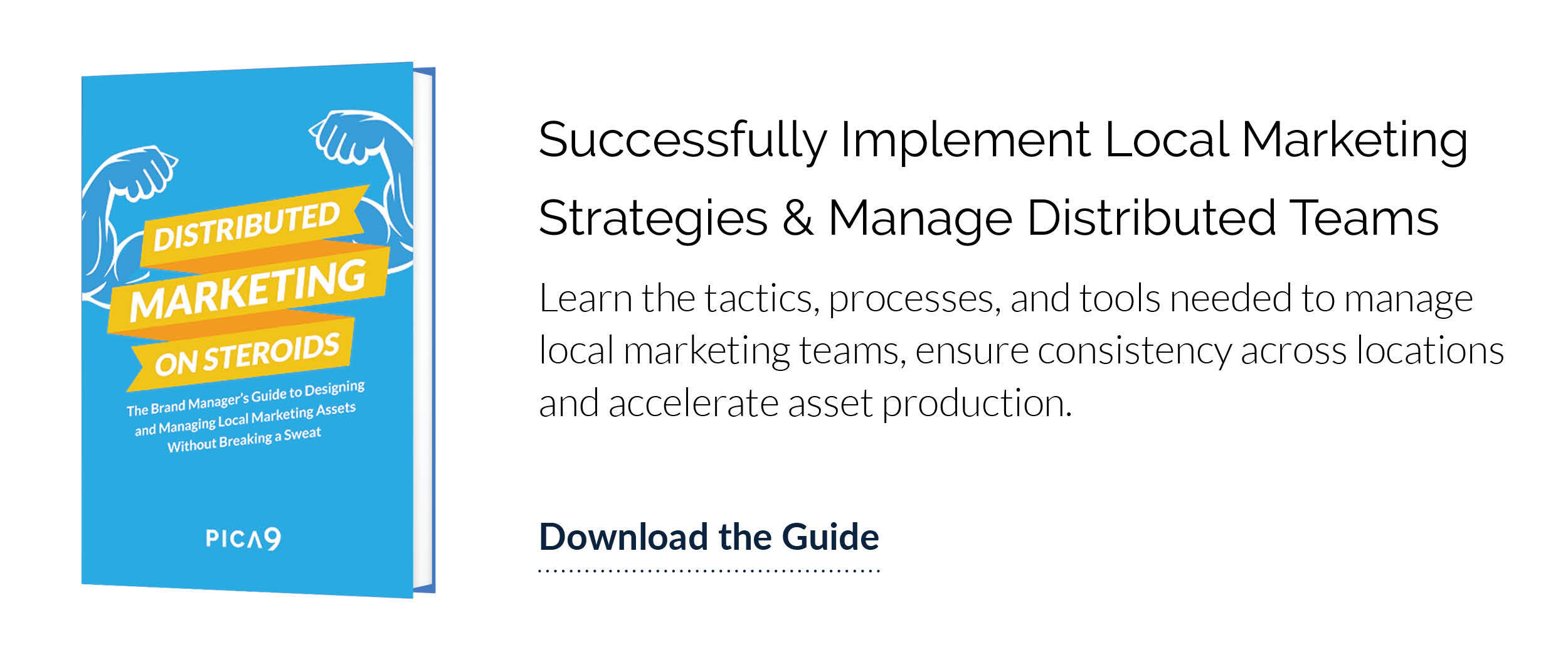Whether you're a team member of a marketing department, an in-house agency, or a marketing services agency, your primary goal is to establish a durable advantage over your competitors by making your brand, or your client's brand, the category leader—first in awareness, then in preference, and ultimately in market share. That's what we're talking about, when we talk about brand equity.
Building and sustaining brand equity is a long journey, and it helps to have clear, measurable signs that your efforts are moving the brand in the right direction. This is particularly the case for distributed brands, where marketing communications aren't just generated by a headquarters team, but also hundreds or thousands of franchisees, dealers or agents in the field.
To help you on your journey, this post provides an overview of the 6 most practical ways to measure brand equity, with a particular focus on the use of those tools and techniques in distributed brand communities.
Brand Equity Definition
Brand equity is defined as the value that your brand delivers to your organization. That value may be derived from higher revenues, lower marketing costs, premium pricing—even favorable negotiating power with vendors. But it's important to remember that all of these sources of value can be expressed in numbers—and that means they can be measured.
The challenge, of course, is to separate out what portion of these numbers stems from brand equity specifically. Take revenues, for instance: your sales team will no doubt claim that 100% of those revenues derive from their efforts. But does that analysis take into account the role that your brand awareness played in getting the sales team in the door in the first place? Or the frequency with which your customers make repeat purchases of your products? By taking the time to assess your brand equity in the six dimensions discussed in this post, you can argue more convincingly for the role that your brand equity efforts have played in your company's most important KPIs—and to fight for the investments that the maintenance of brand equity requires.
1. Brand Awareness
Customer knowledge of your products and services is an important part of brand equity. But even better than customers knowing you, is customers not being able to avoid thinking about your brand. A leading indicator of the consumer's awareness of your company is “conversation share,” or the amount of time your brand comes up in everyday conversations about the products and services you offer. Measuring brand awareness among your target customers can take many forms. Some methodologies used to understand how aware your ideal customers are include:
- Surveys and focus groups
- Local store traffic
- Search volume for your brand and products
- Local media mentions
- Social mentions and reviews
2. Preference Metrics
Consumer preference is a powerful factor in daily purchase decisions; it’s the reason a customer may decide to travel further and spend more money to access a product or service they really like. Aspects of customer preference that can be measured through focus groups, sales data and surveys can include:
Brand Relevance: The extent to which your customers agree your brand provides unique and specific value that is not offered by your competitors.
Accessibility: The ability to provide your target market with your products/services.
Emotional Connection: Your strength in forming emotional connections with customers, a key factor in loyalty.
Brand Value: A measure of how much your customers are willing to pay for your products and services.
3. Channel Partner Engagement
When assessing brand preference, it’s important to look not just as your customers, but your channel partners as well. Are they eager to participate in national promotions and campaigns at the local level? Do they comply with brand standards and guidelines? Do they look for opportunities to enhance and extend the brand within local stores and locations? Do they adopt the systems that you provide for local marketing or do they tend to “go rogue”?
One central component of channel-partner engagement has to do not simply with the quality of the product or services of your organization, but the culture itself. Changes in your organization’s attitude toward, and support for, channel partners can yield big improvements on this front. Moreover, channel partner attitudes can be measured with greater ease, and greater frequency, than typical consumer- or customer-level research projects would permit. You can think of your channel-partner community as a way of keeping a pulse on the strength and appeal of your brand. This is particularly true in dealer- and agent-based partner networks, where the brand has to compete for mind-share and loyalty with other organizations and products.
4. Financial Metrics
Financial metrics surrounding brand equity are directly tied to sales performance. If these indicators, related to the financial value of your brand are increasing, your revenue is likely to be moving in the same direction. Ways to measure brand equity through related financial aspects include:
- Price premium over competition
- Local store sales
- Average transaction value
- Customer lifetime value
- Rate of sustained growth
5. Output Metrics
What if your brand is investing time and budget into brand equity-building and you don’t see results? Output is a measure of marketing activity, which measures the marketing assets that get released to the public. Output looks at how often marketing materials are released, and the type of asset released to the marketplace. Output can also be measured through the impact of your brand-created offers in local markets.
If you have a local marketing system in place, you can asses the usage of the system using our health grade calculator. That can be a quick and easy way to measure output in the field.
Local activity impacts brand equity because assets that aren't being utilized by a local store owner can't influence sales. Similarly, poor-quality output – such as a direct mail offer that's amateurishly edited by a local franchisee – may have a serious negative impact on your brand equity. Three ways to determine how your assets for local marketers are translating into output are:
- Local marketer campaign and asset utilization
- Sales on promoted products
- Customer adoption of loyalty programs
6. Competitive Metrics
Your competitors’ brand equity has a direct influence on how your company's brand equity trends. If competition doubles-down and launches a campaign advertising a pricing adjustment, your customer preference could dip for reasons that have nothing to do with the work you're doing – and everything to do with your competitor's brand.
Competitive metrics can reveal areas where your competition is not providing value to customers, such as missing products, poor customer experiences, or pricing. It can also reveal tactics and campaigns that have resonated with your consumer base. Metrics here include, but are not limited to:
- Customer acquisition rate
- Market share
- Sales lift
- ROI of distribution channels
Part Two: How to Build Brand Equity
Brand equity is built through every "touch" or interaction with the customer. Your advertising at the national and local level supports your brand equity, but so do your local marketers' face-to-face interactions with customers on a daily basis. By understanding that every outbound communication and in-store experience is an opportunity to add to a positive brand impression, brand managers can take control and not just measure brand equity but actually build it in the process.
1. Build Your National Brand
Distributed brand managers don't have direct control over local marketing execution, but they do have control over national-level campaigns. Here are a few tips for ensuring that your national or global brand efforts are amplified and reinforced at the local level.
Conceive of local “legs” for national or global campaigns right from the beginning. Challenge your agency partner or in-house agency to come up with easy and affordable ways for your channel partners to make their local presence a part of your overall efforts.
- Get feedback from key local partners prior to rolling out a new promotion or campaign. Franchise-councils and dealer-councils can be invaluable in this regard. If you have one, make the effort to engage them regularly throughout the year, so that marketing campaigns don’t take the field by surprise.
- Celebrate successful local extensions of national campaigns. Use your extranet, your annual convention, to recognize and reward channel partners who are helping to strengthen your brand.
- Improve your tools for brand consistency regularly. Today, local marketers have developed expectations that brand-level tools will be as easy to use as the best e-commerce websites. Make sure that your systems meet this standard. Are materials easy to find, customize, download and deploy? Is access automated as much as possible (think Single Sign on or SSO)?
- Give consumers and local marketers ample opportunities to offer feedback—and make sure to demonstrate your willingness to listen and respond.
2. Improve Local Marketing Performance
Brand equity at the local level is influenced by the quality of the customer experiences and consistency. If your customers see a product in your national advertisements, go to buy it, and have a great experience, you're on the way to building lasting local brand equity. Just as easily as you build equity through good execution, poor local execution will undermine all those gains.
Delivering consistently great experiences at local storefronts requires brand management teams to define expectations clearly and establish processes, often by using technology, that make it easier for two-way communications between local marketers and brand management teams to occur.
3. Support Local Innovation
How boring would it be if your brand released the exact same direct mail flier with no updates every summer? Pretty boring. Brands need to recast ideas in new and interesting ways to keep their customers excited and engaged. To achieve balance, brand managers need to understand the two primary types of brand consistency:
Repetition: The same thing over and over again.
Innovation: The same idea expressed repeatedly, in a different way.
Semantic consistency is what keeps your brand exciting, while rote consistency builds customer trust. Achieving a balance of these two factors is important to building your existing equity. For distributed enterprises, successfully balancing the two types of consistency requires supporting the right kind of innovation at the local level, making it easy for locals to comply with brand guidelines, and using a mixture of tools and strategic tactics like:
- Brand guidelines
- Brand voice and tone guidelines
- Digital Asset Management technologies
- Two-way communications
Elevate Your Distributed Brand Equity with CampaignDrive
Distributed brand equity is hard-earned and easily lost. It may take just one bad experience at their favorite store to turn a long-time, loyal customer off to your brand. Building on the equity you've already created by delivering a consistently great experience is a challenge. Doing that when you manage a network of thousands of affiliates, can feel next to impossible.
Traditionally, businesses measure brand equity through customer knowledge, preference, and financial metrics. Distributed brands can also determine brand equity through measuring output, local marketing metrics, and competitors. With a solid baseline understanding of distributed brand equity, your organization will be positioned to build equity through national efforts, improving local marketing performance, and support for local innovation.
The key to understanding how your brand is executing against your promise is to understand that your consumers aren’t the only factor to monitor. Your local marketers' perceptions are tied to action, and working to improve their equity measures will have a direct influence on your local execution and equity.
CampaignDrive powered by Pica9 is a distributed marketing platform designed with local marketing in mind. Our secure platform centralizes marketing assets across franchise and enterprise locations to give businesses a holistic view of their collateral and facilitate brand compliance across all branches and affiliates. Brand managers, designers, and local marketers can have the tools they need to stay aligned with brand guidelines as well as automate and streamline processes for faster output.
And the best part is that getting started is simple and easy! You can register for a CampaignDrive demonstration here:





